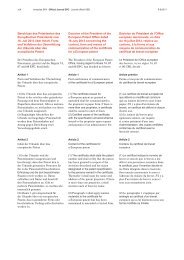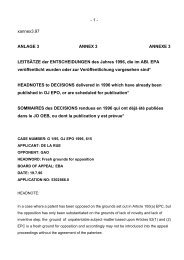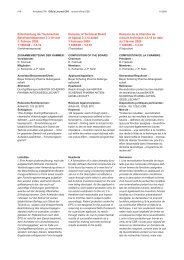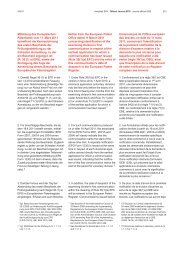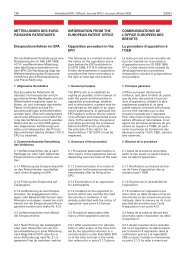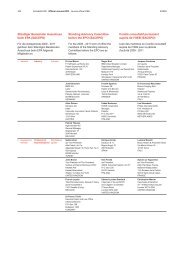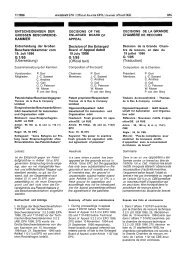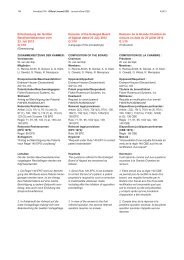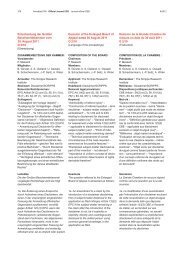Sonderausgabe 1 - European Patent Office
Sonderausgabe 1 - European Patent Office
Sonderausgabe 1 - European Patent Office
You also want an ePaper? Increase the reach of your titles
YUMPU automatically turns print PDFs into web optimized ePapers that Google loves.
2007 <strong>Sonderausgabe</strong> Nr. 1 ABl. EPA / Special edition No. 1 OJ EPO / Edition spéciale n° 1 JO OEB 117<br />
(4) "Pflanzensorte" ist jede pflanzliche<br />
Gesamtheit innerhalb eines einzigen<br />
botanischen Taxons der untersten<br />
bekannten Rangstufe, die unabhängig<br />
davon, ob die Bedingungen für die Erteilung<br />
des Sortenschutzes vollständig<br />
erfüllt sind,<br />
a) durch die sich aus einem bestimmten<br />
Genotyp oder einer bestimmten Kombination<br />
von Genotypen ergebende<br />
Ausprägung der Merkmale definiert,<br />
b) zumindest durch die Ausprägung<br />
eines der erwähnten Merkmale von jeder<br />
anderen pflanzlichen Gesamtheit unterschieden<br />
und<br />
c) in Anbetracht ihrer Eignung, unverändert<br />
vermehrt zu werden, als Einheit<br />
angesehen werden kann.<br />
(5) Ein Verfahren zur Züchtung von<br />
Pflanzen oder Tieren ist im Wesentlichen<br />
biologisch, wenn es vollständig auf<br />
natürlichen Phänomenen wie Kreuzung<br />
oder Selektion beruht.<br />
(6) "Mikrobiologisches Verfahren" ist<br />
jedes Verfahren, bei dem mikrobiologisches<br />
Material verwendet, ein Eingriff in<br />
mikrobiologisches Material durchgeführt<br />
oder mikrobiologisches Material hervorgebracht<br />
wird.<br />
Regel 27<br />
<strong>Patent</strong>ierbare biotechnologische<br />
Erfindungen<br />
Biotechnologische Erfindungen sind<br />
auch dann patentierbar, wenn sie zum<br />
Gegenstand haben:<br />
a) biologisches Material, das mit Hilfe<br />
eines technischen Verfahrens aus seiner<br />
natürlichen Umgebung isoliert oder<br />
hergestellt wird, auch wenn es in der<br />
Natur schon vorhanden war;<br />
b) Pflanzen oder Tiere, wenn die Ausführung<br />
der Erfindung technisch nicht auf<br />
eine bestimmte Pflanzensorte oder Tierrasse<br />
beschränkt ist;<br />
c) ein mikrobiologisches oder sonstiges<br />
technisches Verfahren oder ein durch<br />
diese Verfahren gewonnenes Erzeugnis,<br />
sofern es sich dabei nicht um eine Pflanzensorte<br />
oder Tierrasse handelt.<br />
(4) "Plant variety" means any plant<br />
grouping within a single botanical taxon<br />
of the lowest known rank, which<br />
grouping, irrespective of whether the<br />
conditions for the grant of a plant variety<br />
right are fully met, can be:<br />
(a) defined by the expression of the<br />
characteristics that results from a given<br />
genotype or combination of genotypes,<br />
(b) distinguished from any other plant<br />
grouping by the expression of at least<br />
one of the said characteristics, and<br />
(c) considered as a unit with regard to its<br />
suitability for being propagated<br />
unchanged.<br />
(5) A process for the production of plants<br />
or animals is essentially biological if it<br />
consists entirely of natural phenomena<br />
such as crossing or selection.<br />
(6) "Microbiological process" means any<br />
process involving or performed upon or<br />
resulting in microbiological material.<br />
Rule 27<br />
<strong>Patent</strong>able biotechnological inventions<br />
Biotechnological inventions shall also be<br />
patentable if they concern:<br />
(a) biological material which is isolated<br />
from its natural environment or produced<br />
by means of a technical process even if<br />
it previously occurred in nature;<br />
(b) plants or animals if the technical<br />
feasibility of the invention is not confined<br />
to a particular plant or animal variety;<br />
(c) a microbiological or other technical<br />
process, or a product obtained by means<br />
of such a process other than a plant or<br />
animal variety.<br />
(4) On entend par "variété végétale"<br />
tout ensemble végétal d’un seul taxon<br />
botanique du rang le plus bas connu qui,<br />
qu’il réponde ou non pleinement aux<br />
conditions d’octroi d’une protection des<br />
obtentions végétales, peut :<br />
a) être défini par l’expression des caractères<br />
résultant d’un certain génotype ou<br />
d’une certaine combinaison de génotypes,<br />
b) être distingué de tout autre ensemble<br />
végétal par l’expression d’au moins un<br />
desdits caractères et<br />
c) être considéré comme une entité eu<br />
égard à son aptitude à être reproduit<br />
sans changement.<br />
(5) Un procédé d’obtention de végétaux<br />
ou d’animaux est essentiellement biologique<br />
s’il consiste intégralement en des<br />
phénomènes naturels tels que le croisement<br />
ou la sélection.<br />
(6) On entend par "procédé microbiologique"<br />
tout procédé utilisant une matière<br />
microbiologique, comportant une intervention<br />
sur une matière microbiologique<br />
ou produisant une matière microbiologique.<br />
Règle 27<br />
Inventions biotechnologiques brevetables<br />
Les inventions biotechnologiques sont<br />
également brevetables lorsqu’elles ont<br />
pour objet :<br />
a) une matière biologique isolée de son<br />
environnement naturel ou produite à<br />
l’aide d’un procédé technique, même<br />
lorsqu’elle préexistait à l’état naturel ;<br />
b) des végétaux ou des animaux si la<br />
faisabilité technique de l’invention n’est<br />
pas limitée à une variété végétale ou à<br />
une race animale déterminée ;<br />
c) un procédé microbiologique ou<br />
d’autres procédés techniques, ou un<br />
produit obtenu par ces procédés, dans<br />
la mesure où il ne s’agit pas d’une<br />
variété végétale ou d’une race animale.



